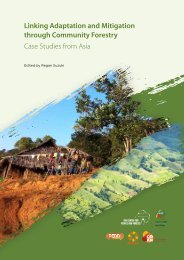Desktop Study on - Regional Climate Change Adaptation ...
Desktop Study on - Regional Climate Change Adaptation ...
Desktop Study on - Regional Climate Change Adaptation ...
Create successful ePaper yourself
Turn your PDF publications into a flip-book with our unique Google optimized e-Paper software.
Assessment of Capacity Gaps and Needs of South East Asia Countries<br />
in Addressing Impacts, Vulnerability and Adaptati<strong>on</strong> to <strong>Climate</strong> Variability and <strong>Climate</strong> <strong>Change</strong><br />
incorporate in the government’s water management<br />
plans to maximize their efficiency, and to ensure<br />
future water availability. Besides, there are few<br />
studies in Thailand using mathematical models to<br />
assess physical property of water resource (water<br />
flow c<strong>on</strong>diti<strong>on</strong>s, element dispersi<strong>on</strong>, sediment<br />
transfer and accumulati<strong>on</strong>), for instance, to plan for<br />
water resource management; studies <strong>on</strong> biological<br />
diversity and the impacts of climate change <strong>on</strong><br />
water resources and fresh water ecosystems<br />
using mathematical models need to be included<br />
(Bo<strong>on</strong>prakrob and Hattirat, 2006).<br />
Agriculture and Food Security Sector<br />
Agricultural activity in Thailand represents 11.4%<br />
of the total GDP. The activity declined its relative<br />
importance in the country’s ec<strong>on</strong>omy (both incomes<br />
and export earnings) due to the industrializati<strong>on</strong><br />
since the 1960s, but agriculture is still the dominant<br />
ec<strong>on</strong>omic activity in rural Thailand and it provides<br />
the benefits of employment and self-sufficiency,<br />
rural social support, and cultural custody, and has<br />
the characteristic of being highly diversified, which<br />
expose the country in many different ways to climate<br />
change.<br />
According to the Internati<strong>on</strong>al Rice Research<br />
Institute (IRRI), Thailand has a land area of 51 milli<strong>on</strong><br />
ha, of which <strong>on</strong>e-third is cultivated for annual crops<br />
and about 7% is under permanent crops. Rice is the<br />
most important crop of the country and Thailand is<br />
a major exporter in the world rice market (exporting<br />
about 6.5 milli<strong>on</strong> t<strong>on</strong>s of milled rice per year);<br />
its reputati<strong>on</strong> for high-quality, l<strong>on</strong>g-grain white<br />
rice, which usually commands a substantial price<br />
advantage over lower grades. Even though declining<br />
in relative importance, it still occupies about 55% of<br />
the total arable land. Rice farmers in the northeast,<br />
the main rice-growing regi<strong>on</strong> and the home of the<br />
famous Jasmine rice, are generally subsistence<br />
farmers, selling <strong>on</strong>ly their excess producti<strong>on</strong>. The<br />
main surplus producti<strong>on</strong> is from the central regi<strong>on</strong><br />
and the north, where the average farm size is three<br />
times larger than in the northeast, and the producti<strong>on</strong><br />
envir<strong>on</strong>ment is favourable (IRRI, 2002).<br />
Other agricultural commodities produced in<br />
significant amounts include fish and fishery<br />
products, tapioca, rubber, grain, and sugar. Exports<br />
of industrially processed foods such as canned<br />
tuna, pineapples, and frozen shrimp are <strong>on</strong> the rise.<br />
Thailand feeds four times its own populati<strong>on</strong>.<br />
Range of Studies Reviewed and<br />
Methods Applied<br />
The Mek<strong>on</strong>g River Commissi<strong>on</strong> report and the<br />
initial Nati<strong>on</strong>al Communicati<strong>on</strong> under the UNFCCC<br />
(the first <strong>on</strong>e based in the sec<strong>on</strong>d) used scenarios<br />
derived from four GCM models in the analysis of<br />
impact <strong>on</strong> agriculture in Thailand. The four models<br />
were (1) CSIRO global coupled ocean-atmospheresea-ice<br />
model (CSIRO coupled GCMs or CGCM), (2)<br />
HadCM2 model (Hadley Centre GCM), (3) ECHAM4/<br />
OPYC3 model and (4) CCCMA’s First Generati<strong>on</strong><br />
Couple General Circulati<strong>on</strong> model (Canadian Centre<br />
for <strong>Climate</strong> Modelling and Analysis) (CGCM1) (OEPP,<br />
2000).<br />
Snidv<strong>on</strong>gs (2006) presents a number of methods<br />
and models in the study <strong>on</strong> extreme hydrological<br />
events and changes in water resources in Southeast<br />
Asia. To study climate change impacts <strong>on</strong> rain-fed<br />
agriculture, the Decisi<strong>on</strong> Support System for Agro<br />
Technology Transfers (DSSAT versi<strong>on</strong> 4.0) was<br />
used for crop modelling to simulate future potential<br />
yield of rice vulnerability. Data c<strong>on</strong>sidered in the<br />
modelling includes parameters such as the range of<br />
temperature, precipitati<strong>on</strong> and solar radiati<strong>on</strong>. The<br />
potential impact of increased floods due to climate<br />
change, however, was not included (Snidv<strong>on</strong>gs,<br />
2006).<br />
Impacts <strong>on</strong> the Agricultural and Food<br />
Sector<br />
There are a wide variety of impacts c<strong>on</strong>cerning<br />
agriculture and food security, in different<br />
scales. For example, as the Greenpeace report<br />
(Bo<strong>on</strong>prakrob and Hattirat, 2006) shows, there<br />
are specific characteristics and parts of the crops<br />
that will be more affected by climate change due<br />
to its sensitiveness. For example, pollen of some<br />
species of rice exposed to higher temperatures than<br />
34°C losses its fertility, hence the crops lose their<br />
productivity by failing to fill the grain, although the<br />
plant is still growing; however, others can tolerate<br />
up to 38°C. Also, crops have their optimum range of<br />
temperatures for growing, which is usually 22-27ºC;<br />
over this temperature crop producti<strong>on</strong> declines.<br />
This is especially important for tropical crops<br />
because they grow in the higher end of the range, so<br />
an increase of temperature may decrease yield. On<br />
the other hand, temperate crops (which grow closer<br />
to the bottom end of the range) yield may increase<br />
(Bo<strong>on</strong>prakrob and Hattirat, 2006).<br />
The Mek<strong>on</strong>g River Commissi<strong>on</strong> report describes<br />
that rain fed rice crops in Thailand are highly<br />
vulnerable to climate change; some results, based<br />
93

















